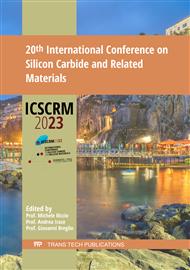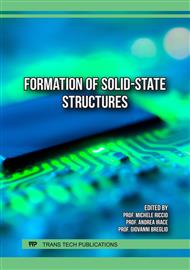[1]
Kol,S., Oral,A. Hf-Based High-κ Dielectrics: A Review. Acta Phys. Pol. A 136, 873-881 (2019).
DOI: 10.12693/aphyspola.136.873
Google Scholar
[2]
Richter, C., Schenk, T., Park, M. H., Tscharntke, F. A., Grimley, E. D., LeBeau, J. M., et al. Si Doped Hafnium Oxide—A "Fragile" Ferroelectric System. Adv. Electron. Mater. 3, 1700131 (2017).
DOI: 10.1002/aelm.201700131
Google Scholar
[3]
Siddiqui, A., Khosa, R. Y., Usman, M. High-k dielectrics for 4H-silicon carbide: present status and future perspectives. J. Mater. Chem. C 9, 5055–5081 (2021).
DOI: 10.1039/d0tc05008c
Google Scholar
[4]
Robertson, J. Band offsets of wide-band-gap oxides and implications for future electronic devices. J. Vac. Sci. Technol. B 18, 1785 (2000)
DOI: 10.1116/1.591472
Google Scholar
[5]
Nawaz, M. On the Evaluation of Gate Dielectrics for 4H-SiC Based Power MOSFETs. Active and Passive Electronic Components 2015, 1–12 (2015)
DOI: 10.1155/2015/651527
Google Scholar
[6]
Narayanan, V., Frank, M. M., eds. Thin films on silicon: electronic and photonic applications. (World Scientific, 2017).
Google Scholar
[7]
Lomenzo, P. D., Takmeel, Q., Moghaddam, S., Nishida, T. Annealing behavior of ferroelectric Si-doped HfO2 thin films. Thin Solid Films 615, 139–144 (2016).
DOI: 10.1016/j.tsf.2016.07.009
Google Scholar
[8]
Materlik, R., Künneth, C., Falkowski, M., Mikolajick, T., Kersch, A. Al-, Y-, and La-doping effects favoring intrinsic and field induced ferroelectricity in HfO2: A first principles study. Journal of Applied Physics 123, 164101 (2018).
DOI: 10.1063/1.5021746
Google Scholar
[9]
Holzwarth, U., Gibson, N. The Scherrer equation versus the 'Debye-Scherrer equation'. Nature Nanotech 6, 534–534 (2011).
DOI: 10.1038/nnano.2011.145
Google Scholar
[10]
Lu, Y., Hall, S., Tan, L. Z., Mitrovic, I. Z., Davey, W. M., Raeissi, B., et al. Leakage current effects on C-V plots of high-k metal-oxide-semiconductor capacitors. J. Vac. Sci. Technol. B 27, 352 (2009).
DOI: 10.1116/1.3025910
Google Scholar
[11]
Weckbrodt, J., Ginot, N., Batard, C., Azzopardi, S. Monitoring of Gate Leakage Current on SiC Power MOSFETs: An Estimation Method for Smart Gate Drivers. IEEE Trans. Power Electron. 36, 8752–8760 (2021).
DOI: 10.1109/tpel.2021.3056648
Google Scholar
[12]
Park, M. H., Lee, Y. H., Kim, H. J., Kim, Y. J., Moon, T., Kim, K. D., et al. Ferroelectricity and Antiferroelectricity of Doped Thin HfO 2 -Based Films. Adv. Mater. 27, 1811–1831 (2015).
DOI: 10.1002/adma.201404531
Google Scholar
[13]
Schroeder, U., Mueller, S., Mueller, J., Yurchuk, E., Martin, D., Adelmann, C., et al. Hafnium Oxide Based CMOS Compatible Ferroelectric Materials. ECS J. Solid State Sci. Technol. 2, N69–N72 (2013).
DOI: 10.1149/2.010304jss
Google Scholar
[14]
Chiu, F.-C. A Review on Conduction Mechanisms in Dielectric Films. Advances in Materials Science and Engineering 2014, 1–18 (2014).
Google Scholar
[15]
DiMaria, D. J. Explanation for the oxide thickness dependence of breakdown characteristics of metal-oxide-semiconductor structures. Microelectronic Engineering 36, 317–320 (1997).
DOI: 10.1016/s0167-9317(97)00072-5
Google Scholar
[16]
Kauerauf, T., Degraeve, R., Cartier, E., Govoreanu, B., Blomme, P., Kaczer, B., et al. Towards understanding degradation and breakdown of SiO/sub 2//high-k stacks. in Digest. International Electron Devices Meeting, p.521–524 (IEEE, 2002).
DOI: 10.1109/iedm.2002.1175894
Google Scholar
[17]
Zacharias, M., Bläsing, J., Veit, P., Tsybeskov, L., Hirschman, K., Fauchet, P. M. Thermal crystallization of amorphous Si/SiO2 superlattices. Applied Physics Letters 74, 2614–2616 (1999).
DOI: 10.1063/1.123914
Google Scholar
[18]
Navrotsky, A. Thermochemical insights into refractory ceramic materials based on oxides with large tetravalent cations. J. Mater. Chem. 15, 1883 (2005).
DOI: 10.1039/b417143h
Google Scholar
[19]
Ushakov, S.V., Navrotsky, A., Yang, Y., Stemmer, S., Kukli, K., Ritala, M., et al. Crystallization in hafnia- and zirconia-based systems. Phys. Stat. Sol. (b) 241, 2268–2278 (2004).
DOI: 10.1002/pssb.200404935
Google Scholar



